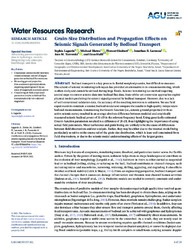Grain‐Size Distribution and Propagation Effects on Seismic Signals Generated by Bedload Transport
Lagarde, Sophie; Dietze, Michael; Gimbert, Florent; Laronne, Jonathan B.; Turowski, Jens M.; Halfi, Eran, 2021: Grain‐Size Distribution and Propagation Effects on Seismic Signals Generated by Bedload Transport. In: Water Resources Research, Band 57, 4, DOI: 10.23689/fidgeo-4320.
 |
Dokument öffnen: |
Bedload transport is a key process in fluvial morphodynamics, but difficult to measure. The advent of seismic monitoring techniques has provided an alternative to in‐stream monitoring, which is often costly and cannot be utilized during large floods. Seismic monitoring is a method requiring several steps to convert seismic data into bedload flux data. State‐of‐the‐art conversion approaches exploit physical models predicting the seismic signal generated by bedload transport. However, due to a lack of well‐constrained validation data, the accuracy of the resulting inversions is unknown. We use field experiments to constrain a seismic bedload model and compare the results to high‐quality independent bedload measurements. Constraining the Green's function (i.e., seismic ground properties) with an active seismic survey resulted in an average absolute difference between modeled and empirically measured seismic bedload power of 11 dB in the relevant frequency band. Using generically estimated Green's function parameters resulted in a difference of 20 dB, thus highlighting the importance of using actual field parameters. Water turbulence and grain hiding are unlikely to be the cause of differences between field observations and our analysis. Rather, they may be either due to the inverted model being particularly sensitive to the coarse tail of the grain‐size distribution, which is least well constrained from field observations, or due to the seismic model underestimating effects of the largest grains. Key Points:
Constrained seismic model inversion reveals dominant control of largest grain size on bedload flux estimates
Measuring ground properties from a seismic experiment allows improving spectrogram fit by an order of magnitude in seismic power
Considering all field‐constrained parameters results in bedload flux overestimation by two orders of magnitude
Statistik:
ZugriffsstatistikSammlung:
This is an open access article under the terms of the Creative Commons Attribution License, which permits use, distribution and reproduction in any medium, provided the original work is properly cited.

